Foreign beverage companies are looking to make inroads into Vietnam which is standing out as one of the most promising markets thanks to its sustained growth.
Consumption of beverages, including alcoholic and non-alcoholic drinks, in Vietnam is on the rise with an annual increase of 6%-8%, reaching 81.6 billion liters in 2016, and is projected to hit roughly 109 billion liters by 2020.
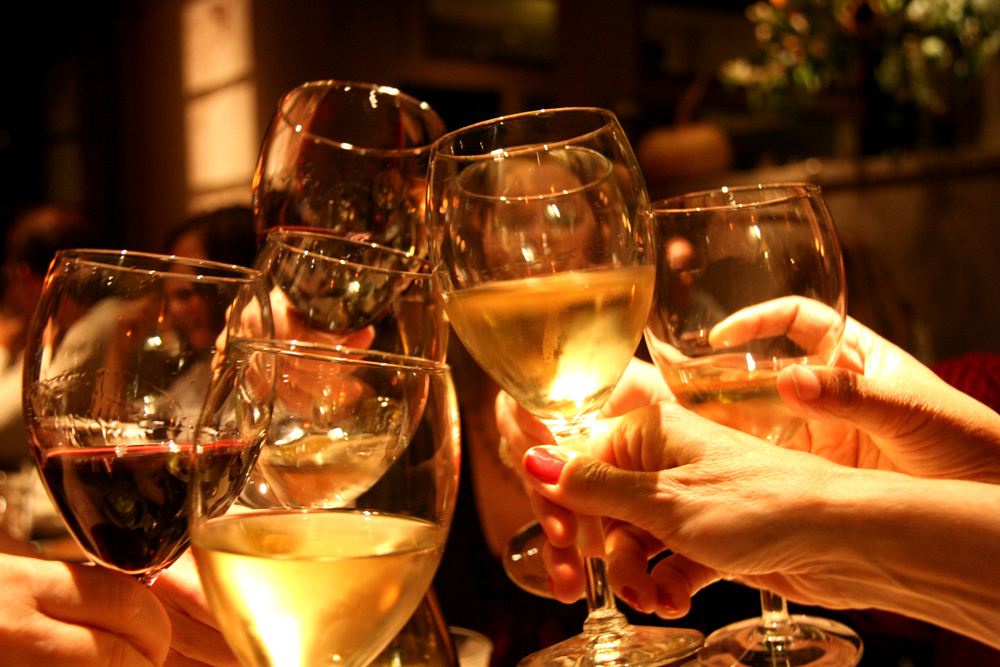 Beverage consumption in Vietnam posts annual growth rate of 6%-8%. Source: EVBN
|
The industry is characterized by a growing population and a rising number of middle income individuals, according to the EU-Vietnam Business Network (EVBN), a project co-funded by the European Union and established in 2014.
Consequently, various foreign beverage companies have been expanding their footing to this lucrative market, creating a competitive market environment.
While local manufacturers diversify their product portfolios in response to more demanding consumers, the high-end segment, which often brings higher margin, is dominated by foreign players, especially in the alcoholic drinks sector.
The involvement of foreign players has posed certain difficulties for local beverage manufacturers due to the limited capital budget and expertise in establishing influential brand names, according to a report by the EVBN, which strengthens the EU business sector in facilitating market access in Vietnam by advocating and engaging primarily with the Government of Vietnam, the Vietnamese business sector and other stakeholders.
The master plan of development for beverage industry by 2025 by the Ministry of Industry and Trade has defined that:
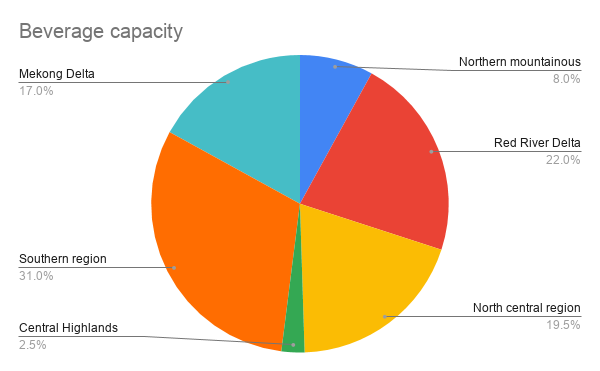 Beverage capacity in Vietnam in 2015-2020. Data: EVBN. Chart: Linh Pham
|
(1) Beverage capacity in the northern mountainous region is targeted to account for 8% of the
country’s total by 2025, the Red River Delta 22%, the north-central region 19.5%, the Central Highlands 2.5%, the southern region 31%, and the Mekong Delta 17%.
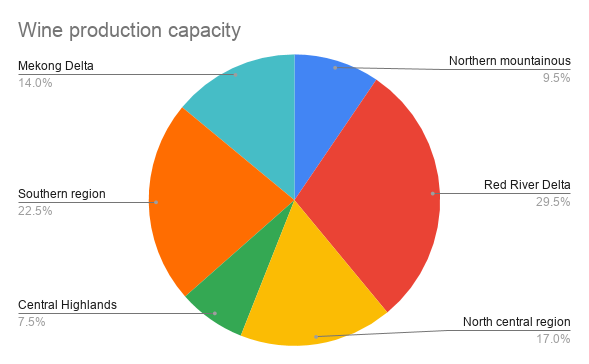 Wine production capacity in Vietnam in 2015-2020. Data: EVBN. Chart: Linh Pham
|
(2) Wine production capacity will be given focus in the Red River Delta, the southern region and the Mekong Delta. The central highlands and north-central region are to develop fruit wine while other regions are to develop white wine and mixed wine. Production of wine in the northern mountainous region is to account for 9.5% of the country’s total by 2025, the Red River Delta 29.5%, the north-central region 17%, the Central Highlands 7.5%, the southern region 22.5%, and the Mekong Delta 14%.
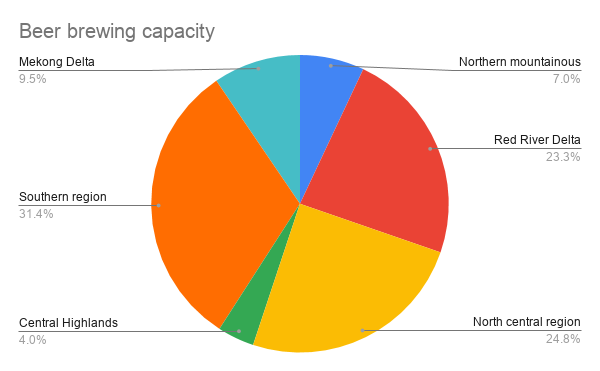 Beer brewing capacity in Vietnam in 2015-2020. Data: EVBN. Chart. Linh Pham
|
(3) The beer brewing capacity in the northern mountainous region accounts for 7% of the country’s total, the Red River Delta 23.3%, the north-central region 24.8%, the Central Highlands 4%, the southern region 31.4%, and the Mekong Delta 9.5%.
Non-alcoholic drinks
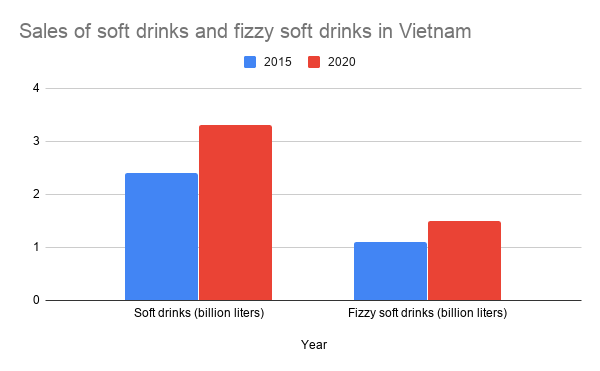 Sales of soft drinks and fizzy soft drinks in Vietnam in 2015-2020. Data: EVBN. Chart: Linh Pham
|
In 2015, volume sales of soft drinks (juices, bottled water, ready-to-drink tea/coffee) and fizzy soft drinks in Vietnam reached 2.4 billion liters and 1.1 billion liters, respectively. By 2020, the sales of each sector are estimated to be 3.3 billion liters and 1.5 billion liters, respectively.
In terms of sales value, these subsectors will be one of the fastest growing in the fast-moving consumer goods (FMCG) industry, with a forecast US$7.65 billion in sales in 2020.
The large market and high profitability are the reasons foreign manufacturers pour their investment into Vietnam. A more competitive landscape has called both domestic and foreign players to be more innovative in terms of diversifying their product offerings, retailing strategy, and marketing spending.
Alcoholic drinks
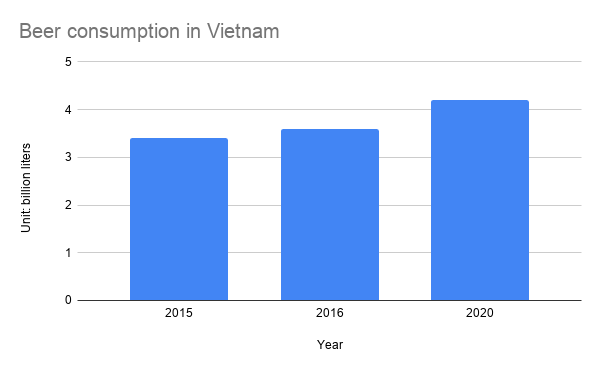 Beer consumption in Vietnam in 2015-2020. Data: EVBN. Chart: Linh Pham
|
Beer
Vietnam is the biggest beer market in Southeast Asia. In 2015, local consumption of beer products reached 3.4 billion liters. The figure climbed to 3.6 billion liters in 2016 and is expected to grow considerably to 4.2 billion liters in 2020.
Consumption per capita has continuously risen during this period; by 2020, it is estimated that each Vietnamese will consume over 42 liters of beer per year. This high level of consumption has put the country in the top 10 Asian consumers of alcohol.
The Ministry of Industry and Trade has recently released a Decision on the development plan for beer sector with a vision for beer production to reach 5.5 billion liters in 2030.
This master plan strengthens the important contribution of beer in Vietnam’s alcoholic drinks sector as it has attracted interest from both local and international brewers. The development of beer sub-sector is expected to be driven more prominently by global players as the Vietnamese government is seeking to reduce its participation in Sabeco and Habeco, two major breweries in Vietnam, which respectively hold 46% and 14.8% of the total beer market share.
Wine and spirits
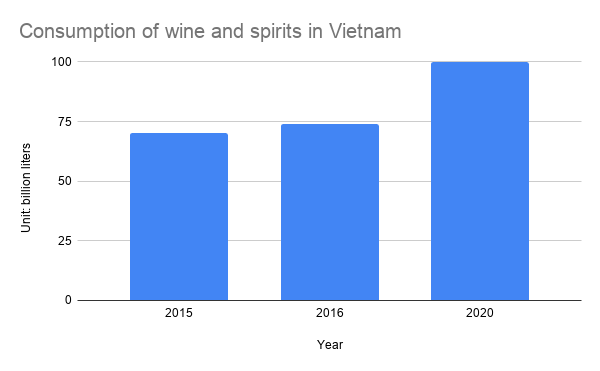 Consumption of wine and spirits in Vietnam in 2015-2020. Data: EVBN. Chart: Linh Pham
|
In 2015, consumption of wine and spirits in Vietnam reached 70 million liters. This number reached 74 million liters in 2016 and is forecast to grow to 100 million liters in 2020.
In general, wine and spirits can be considered as “infant” sub-sectors, having been held back by an absence of multinational investment and by their relatively higher price tags. However, the robust forecast trend is backed by a rising affluent Vietnamese population.
Nevertheless, it is important to mention that due to the gap in income distribution between urban and rural areas, the consumption of wine and spirits is concentrated in urban centers such as Hanoi, Ho Chi Minh City and Da Nang.
In terms of the local manufacturing plan to 2030, the country’s target is to produce 350 million liters of liquors (of which 50% are industrial production).
Conclusion
Vietnamese consumers are shifting towards consumption of beverages with higher value, creating opportunities for penetration to upper-class beverage segments. Though both local and foreign players have attempted to act in response to this shift, overseas companies are currently at edge due to the preference for international brands of Vietnamese consumers.
Besides an improvement in demographic profile, it should be noted that Vietnamese consumers are the most health-conscious in Southeast Asia, calling for manufacturers to start rethinking market offerings which will be calibrated towards healthier product portfolio such as fruit juices or herbal teas.
Ongoing development of the tourism industry and retailing network in Vietnam also act as catalysts for the growth of beverage industry as they create further demands for high-end drink segments as well as enhance the availability of beverage product lines via modern trade channels, the EVBN concluded. Hanoitimes
Linh Pham

Vietnam’s food and beverage sector draws foreign firms’ interest
Vietnam has become an increasingly attractive destination for international enterprises in the food, beverages and packaging industry thanks to its rapid economic growth and rising consumer demand.

VN food and beverage sector draws foreign firms’ interest
Vietnam has become an increasingly attractive destination for international enterprises in the food, beverages and packaging industry thanks to its rapid economic growth and rising consumer demand.
 Listed among leading Asian consumers of alcoholic drinks, Vietnam remains potential for foreign investors." itemprop="description" />
Listed among leading Asian consumers of alcoholic drinks, Vietnam remains potential for foreign investors." itemprop="description" />